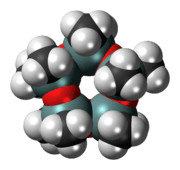Decamethylcyclopentasiloxane
 | |
 | |
| Names | |
|---|---|
| IUPAC name
Decamethyl-1,3,5,7,9,2,4,6,8,10-pentaoxapentasilecane | |
| Other names
Cyclopentamethicone Cyclic dimethylsiloxane pentamer | |
| Identifiers | |
| 541-02-6 | |
| 3D model (Jmol) | Interactive image Interactive image |
| 1800166 | |
| ChemSpider | 10451 |
| ECHA InfoCard | 100.007.969 |
| EC Number | 208-764-9 |
| MeSH | Decamethylcyclopentasiloxane |
| PubChem | 10913 |
| RTECS number | GY5945200 |
| UNII | 0THT5PCI0R |
| |
| |
| Properties | |
| C10H30O5Si5 | |
| Molar mass | 370.77 g·mol−1 |
| Appearance | Colourless liquid |
| Density | 0.958 g cm−3 |
| Melting point | −47 °C; −53 °F; 226 K |
| Boiling point | 210 °C (410 °F; 483 K) |
| 17.03±0.72 ppb (23 °C) [1] | |
| Vapor pressure | 20.4±1.1 Pa (25 °C) [2] |
| Viscosity | 3.74 cP |
| Hazards | |
| Safety data sheet | External MSDS |
| EU classification (DSD) |
|
| R-phrases | R36/37/38 |
| S-phrases | S23, S24/25 |
| NFPA 704 | |
| Flash point | 73 °C (163 °F; 346 K) |
| Related compounds | |
| Related Organosilicon compounds |
Octamethylcyclotetrasiloxane |
| Except where otherwise noted, data are given for materials in their standard state (at 25 °C [77 °F], 100 kPa). | |
| | |
| Infobox references | |
Decamethylcyclopentasiloxane (D5) is an organosilicon compound with the formula [(CH3)2SiO]5. It is a colorless and odorless liquid that is slightly volatile.[3] The compound is classified as a cyclomethicone. Such fluids are commonly used in cosmetics, such as deodorants, sunblocks, hair sprays and skin care products. It is becoming more common in hair conditioners, as it makes the hair easier to brush without breakage. It is also used as part of silicone based personal lubricants. D5 is considered an emollient. In Canada, among the volume used in consumer products approximately 70% were for antiperspirants and 20% for hair care products.[4]
Production
Commercially D5, is produced by cracking polysiloxanes. The silicone polymer equilibrated in the presence of strong base to give the pentamer:
- n/5 [(CH3)2SiO]n → n [(CH3)2SiO]5
The tetramer octamethylcyclotetrasiloxane is also generated. These two cyclic species are separated from the polymer by distillation.[5]
Environment
D5 and D4 have attracted attention because they are pervasive. Although never reported as being toxic, one report suggests cyclic siloxanes can be detected in some species of aquatic life.[6] However, other scientific reviews have determined that "Siloxane D5 does not pose a danger to the environment."[7]
References
- ↑ Sudarsanan Varaprath; Cecil L. Frye; Jerry Hamelink (1996). "Aqueous solubility of permethylsiloxanes (silicones)". Environmental Toxicology and Chemistry. 15 (8): 1263–1265. doi:10.1002/etc.5620150803.
- ↑ Ying Duan Lei; Frank Wania; Dan Mathers (2010). "Temperature-Dependent Vapor Pressure of Selected Cyclic and Linear Polydimethylsiloxane Oligomers". Journal of Chemical & Engineering Data. 55 (12): 5868–5873. doi:10.1021/je100835n.
- ↑ Record of Decamethylcyclopentasiloxan in the GESTIS Substance Database of the IFA, accessed on 25. September 2015.
- ↑ Donald Mackay, Christina E. Cowan-Ellsberry, David E. Powell, Kent B. Woodburn, Shihe Xu, Gary E. Kozerski, Jaeshin Kim (2015). "Decamethylcyclopentasiloxane (D5) environmental sources, fate, transport, and routes of exposure". Environmental Toxicology and Chemistry. 34 (12): 2689–2702. doi:10.1002/etc.2941.
- ↑ Moretto, Hans-Heinrich; Schulze, Manfred; Wagner, Gebhard (2005). "Silicones". Ullmann's Encyclopedia of Industrial Chemistry. Weinheim: Wiley-VCH. doi:10.1002/14356007.a24_057.
- ↑ Wang, De-Gao; Norwood, Warren; Alaee, Mehran; Byer, Jonathan D.; Brimble, Samantha "Review of recent advances in research on the toxicity, detection, occurrence and fate of cyclic volatile methyl siloxanes in the environment" Chemosphere 2013, volume 93, pages 711–725. doi:10.1016/j.chemosphere.2012.10.041
- ↑ Report of the Board of Review for Decamethylcyclopentasiloxane (Siloxane D5) established under Section 333(1) of the Canadian Environmental Protection Act of 1999, October 20, 2011
External links
- Record in the Household Products Database of NLM
- "Toxicology of decamethylcyclopentasiloxane (D5)". doi:10.1016/j.yrtph.2015.06.011.
